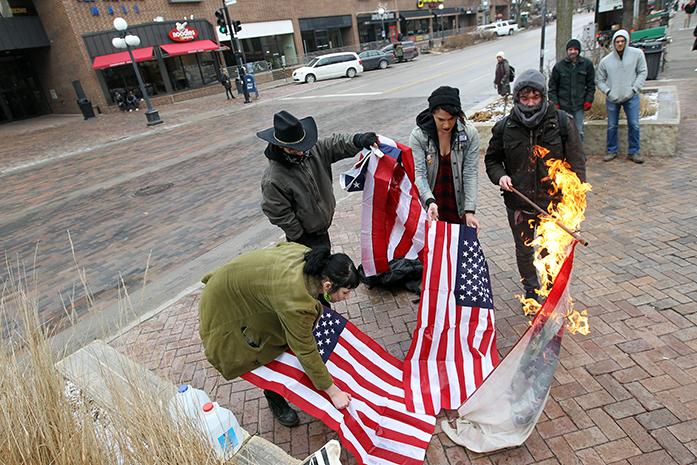By Jack Dugan
President Trump’s inauguration has lit a fire in the once timid liberal heart. Since the downfall of Occupy Wall Street, the vocal left had reserved itself to casual marches, often spearheaded by government-validated unions and typically only culminating to some bucket drumming and lackluster chants. Now, with Trump in office for barely a week, dissent has erupted into actions designed to agitate.
On Thursday, a group of the radically inclined assembled in front of the Clinton Street Wells Fargo with American flags and lighter fluid. Three flags were doused and set on fire while protesters denounced Trump, crony corporatism, and American imperialism. Within moments, a FedEx employee shoved into the crowd discharging a fire extinguisher and ripped the flags from the protesters’ hands. When the FedEx employee was removed from the situation, fuming in his delivery vehicle, another flag was set ablaze. Cars that passed by stuck defiantly patriotic middle fingers out their window, dissent met with disgust.
The disgust likely stems from the anti-veteran rhetoric that has been framed around the act of flag-burning. Though, for the most part, this is rhetoric that has been drummed up by those who oppose such First Amendment extremities.
According to the protest’s participants, anti-veteran sentiment is far from the case. Local activist Kelli Ebensberger said, “This act isn’t about disrespecting veterans. That flag represents the corrupt policies America continues to enforce internationally and domestically. American exceptionalism is a plague that kills and has killed hundreds of thousands. This most recent onslaught of policies are striving to criminalize dissent and diversity and pushing against information that attempts to condemn the abusive capitalist system driving our country, and we are not going to sit down quietly and take it.”
Of course, Ebensberger speaks about the gag Trump has put on the Environmental Protection Agency and the most recent anti-protest bill that has been introduced in Des Moines, among other things.
On the subject of the suppression of protest, Paul Osgerby, one of the event’s organizers, said, “Dissent is at its most effective when it’s a public spectacle. Burning the flag is a protected, nonviolent form of that. I think it’s crucial for people to observe the flag as multidimensional. It’s not just a symbol of freedom or liberty that’s given to fallen service-people; the genocide of Native Americans, slavery of African Americans, suppression of citizenship for women, the internment of Japanese Americans during WWII, pillaging innocent people during the Vietnam War, and the list goes on and on, have all been done in the name of the American flag.”
The act of flag burning is an act of political iconoclasm, a steadfast tradition rooted in the American collective cognizance. To methodically challenge, question, and attack government institutions and their symbols that work to govern us is as democratic as casting a ballot. The icon-worship involved with symbols of nationality is a tragically 19th-century sentiment. In an age of rapid globalization, nationality as a means of forcing a collective identity on the often very eclectic populations found in these nations is as arbitrary as the borders drawn on the maps by old rich men hundreds of years ago. And to most of the other folks partaking in globalization (read: the rest of the world), the American flag is often associated with austerity measures, economic sanctions, unapologetic ecological destruction, or bombs falling from the sky.
Trump is now the face of America, and thus, the American flag is in part an extension of him. If the Trump administration plans to ravage the planet through the “America First” energy plan, to continue drone strikes of remote Middle Eastern villages through the U.S. Targeted Killing Program, and continue to subjugate large swaths of the global south through exploitative global markets, I say let it burn.



